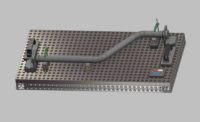Since coordinate measuring machines (CMMs) began to be used, CMM operators have searched for more practical methods to hold and clamp products. Dedicated fixturing is the traditional way to hold a part, but emerging fixture technology can bring features and benefits to the workplace that traditional fixturing cannot. These fixtures, which are often referred to as adaptable, modular, re-usable and reclaimable, bring benefits such as shorter design and build time, faster set up, higher accuracies, cleaner work place and less manufacturing processes, and they are financially, ergonomically and ecologically sound.
Take this scenario, for example: The flexible inspection cell supervisor walks into the fixture department in need of a fixture-yesterday. The expectation is to relay the fixturing problem to the tooling staff and move on to another issue, leaving the fixture problem with someone who is not sure how to resolve the requirement in the time allocated. Now what? Traditional fixtures must go through a design and manufacturing process that can take up to six weeks.
With a modular, or flexible, fixture system, the manufacturing process allows the designer to make changes to the computer-aided design (CAD) data and redesign the tool for concept approval much the same as a traditional tool build process. Often the modular design is conceived with future changes in mind. It should allow plenty of clearance for the CMM to position for measurements with movable or removable net locators. The CMM operator or the fixture department is now ready for reconfiguration of the system. The list of reusable components will be relocated and fastened on the surface plate or base of the fixture. The components are selected based on the design and often within a kit that can be reused. The fixture is constructed and used for the specified part and then either stored for future use or broken down for reconfiguration on the next project. The time it takes to design, build and reuse the fixture is two days, on average.
The introduction of modular fixturing has enabled manufacturers to cut costs in many areas, but there are still skeptics. A common complaint by many tool manufacturers about modular fixturing is that it eliminates jobs. In reality, it changes the way people do business. When technology migrated from typewriters to word processors, the same workforce was used. The same goes for fixture building in most cases. With proper education and retraining of current toolmakers, welders and machinists, modular systems can be profitable and beneficial.
